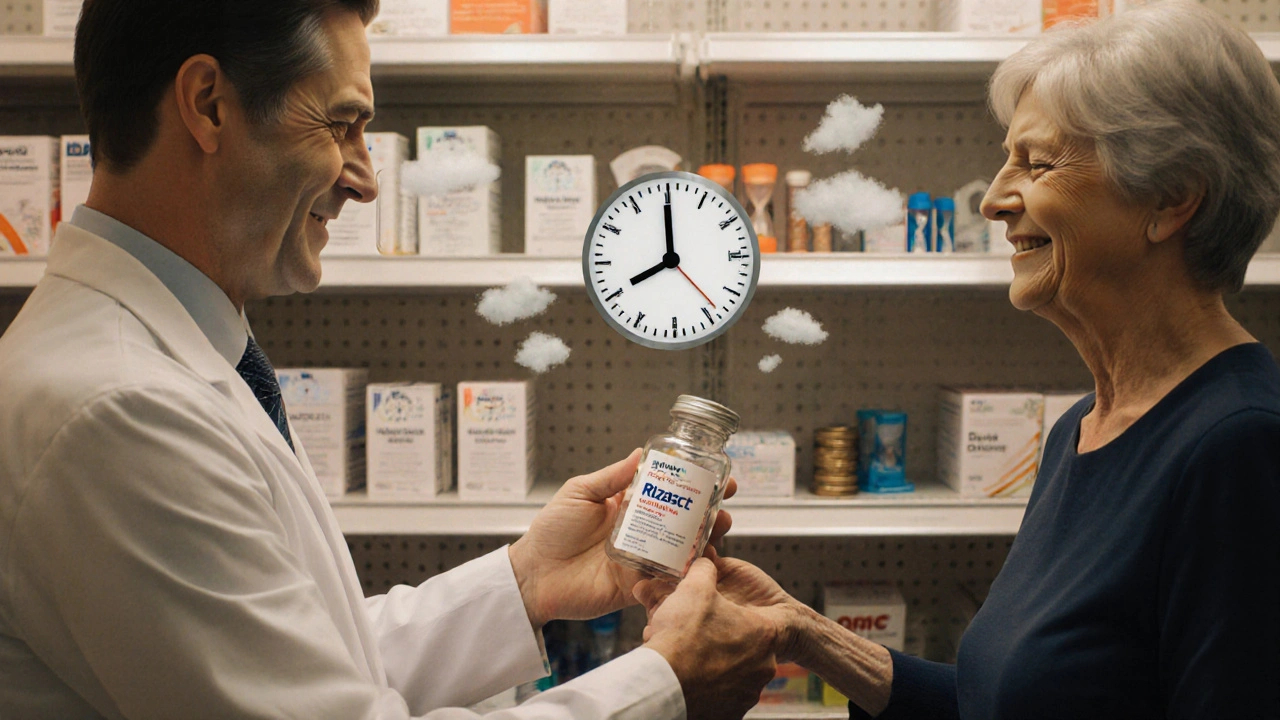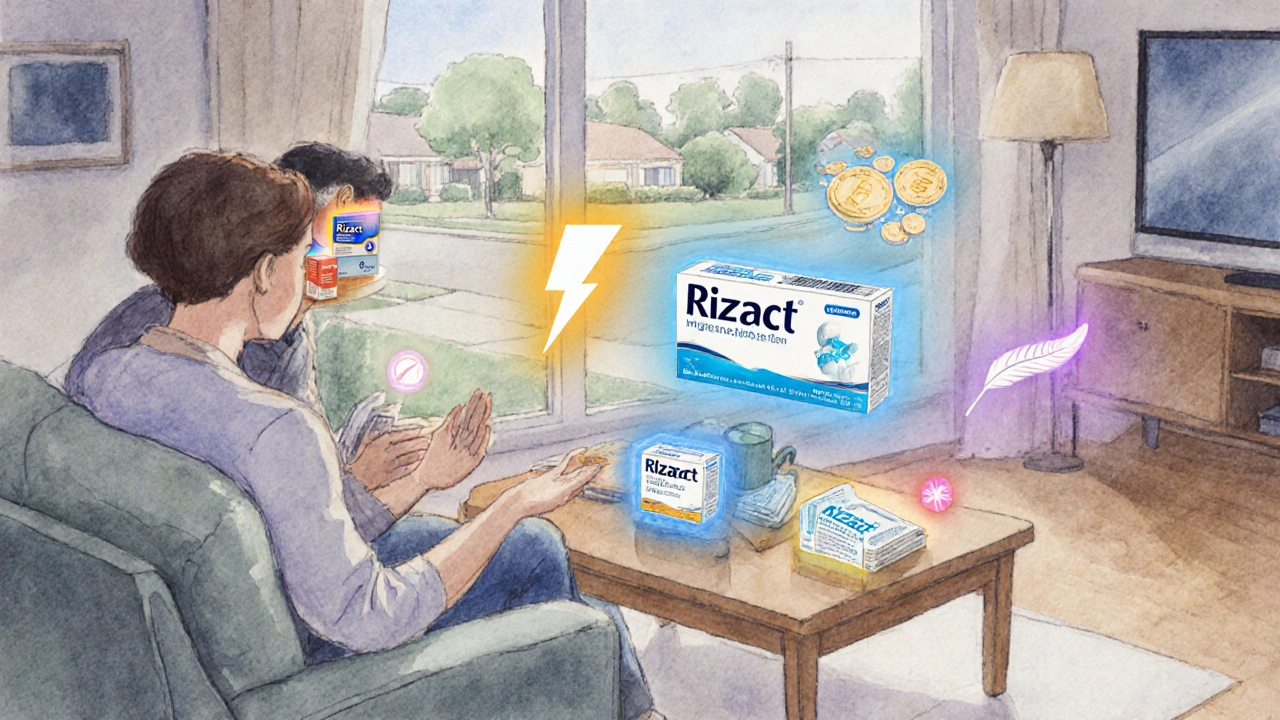Triptan Comparison Tool
Select a triptan to compare its features with Rizact:
Rizact is a brand name for the triptan drug rizatriptan, used to treat acute migraine attacks. When a migraine strikes, the goal is fast relief with minimal side‑effects, and Rizact promises a quick onset while fitting into a busy schedule. Below is a practical guide that lets you compare Rizact with the most common alternatives and decide which pill matches your migraine pattern.
- Rizact offers a rapid onset (as fast as 30minutes) and a short half‑life.
- Other triptans such as Sumatriptan, Zolmitriptan, Naratriptan and Eletriptan differ in speed, duration and tolerability.
- Non‑triptan options - NSAIDs like Ibuprofen and CGRP antagonists such as Erenumab - serve different roles, from acute rescue to preventive care.
- Key decision factors include onset time, side‑effect profile, contraindications, and out‑of‑pocket cost.
- Practical tips help you minimise risks and maximise relief.
How Triptans Work: The Shared Mechanism
All triptans, including Rizact, are serotonin 5‑HT1B/5‑HT1D receptor agonists. By tightening cranial blood vessels and blocking pain‑signal release, they abort the migraine cascade. This class effect explains why they all provide relief, yet subtle differences in chemical structure dictate how quickly they act and how long they last.
Rizact Compared With Other Triptans
Below are the five most prescribed oral triptans. Each entry starts with a brief definition that includes key attributes - dose range, onset, duration, common side‑effects and typical cost in Australian dollars.
Sumatriptan is a first‑generation triptan available as 25‑mg tablets, nasal spray and injection, known for a strong efficacy record.
- Typical dose: 50mg (max 200mg/24h)
- Onset: 30‑60min (tablet), <15min (nasal)
- Duration: 4‑6h
- Side‑effects: chest tightness, dizziness, dry mouth
- Approx. cost:$12‑$18 per tablet
Zolmitriptan is a second‑generation triptan usually prescribed in 2.5mg tablets or nasal spray, praised for fast absorption.
- Typical dose: 5mg (max 10mg/24h)
- Onset: 15‑30min
- Duration: 3‑4h
- Side‑effects: tingling, fatigue, mild nausea
- Approx. cost:$10‑$16 per tablet
Naratriptan is a long‑acting triptan taken at 2.5mg (or 1mg ODT), often recommended for prolonged migraines.
- Typical dose: 2.5mg (max 5mg/24h)
- Onset: 45‑60min
- Duration: 8‑12h
- Side‑effects: drowsiness, muscle pain
- Approx. cost:$13‑$20 per tablet
Eletriptan is a high‑potency triptan available in 40‑mg tablets, noted for strong pain relief even in severe attacks.
- Typical dose: 40mg (max 80mg/24h)
- Onset: 30‑45min
- Duration: 4‑6h
- Side‑effects: dry mouth, fatigue, occasional chest pressure
- Approx. cost:$15‑$22 per tablet
Non‑Triptan Acute Options
When triptans aren’t suitable (e.g., cardiovascular risk), other classes step in.
Ibuprofen is a non‑steroidal anti‑inflammatory drug (NSAID) that reduces inflammation and pain, commonly used in 200‑400mg doses for migraine.
- Onset: 30‑60min
- Duration: 4‑6h
- Side‑effects: stomach upset, rare ulceration
- Cost:$2‑$5 per tablet
Erenumab is a monthly injectable CGRP monoclonal antibody used for migraine prevention, not acute relief. While not a direct alternative for a single attack, it illustrates how the treatment landscape is expanding beyond triptans.

Side‑Effect & Contraindication Snapshot
Understanding safety is critical. All triptans share a box‑warning for patients with uncontrolled hypertension, coronary artery disease, or a history of stroke. Below is a quick safety matrix.
| Drug | Common Side‑effects | Major Contraindications | Typical Onset | Duration | Approx. Cost (AU$) |
|---|---|---|---|---|---|
| Rizact (rizatriptan) | Nausea, dizziness, fatigue | Uncontrolled HTN, CAD, recent MI | 30‑45min | 4‑6h | 10‑15 |
| Sumatriptan | Chest tightness, tingling | Same as above + severe hepatic disease | 30‑60min | 4‑6h | 12‑18 |
| Zolmitriptan | Dry mouth, drowsiness | Same as above | 15‑30min | 3‑4h | 10‑16 |
| Naratriptan | Drowsiness, muscle pain | Same as above | 45‑60min | 8‑12h | 13‑20 |
| Eletriptan | Fatigue, dry mouth | Same as above | 30‑45min | 4‑6h | 15‑22 |
Choosing the Right Acute Migraine Pill
Ask yourself these four questions before reaching for the next tablet:
- How fast do I need relief? If you need a rescue within 15minutes, Zolmitriptan nasal spray or Rizact’s 10‑mg tablet are top picks.
- How long does my migraine usually last? For attacks that linger beyond 8hours, Naratriptan’s extended duration can prevent a second dose.
- Do I have cardiovascular risk factors? Patients with hypertension or heart disease should talk to a GP before any triptan; an NSAID or CGRP‑targeted therapy may be safer.
- What does my insurance or PBS cover? Cost varies widely; Rizact often lands in the mid‑range, while generic sumatriptan can be cheaper if a brand isn’t required.
Based on the answers, you can map to a specific drug:
- Fast, moderate‑duration: Rizact or Zolmitriptan.
- Strongest pain knock‑out: Eletriptan (if tolerable).
- Very long attacks: Naratriptan.
- Contraindicated to triptans: Ibuprofen or a CGRP antagonist for preventive use.
Practical Tips for Safe Use
- Take the dose with water, not within 2hours of a heavy meal - food can delay absorption. \n
- Never exceed the maximum daily dose; stacking two triptans raises the risk of serotonin syndrome.
- If nausea persists, consider an anti‑emetic (e.g., metoclopramide) 30minutes before the triptan.
- Keep a headache diary: record onset, severity, drug taken, and time to relief. Patterns help your doctor fine‑tune therapy.
- Store tablets below 30°C and away from moisture to preserve potency.
Related Concepts and Next Steps
Understanding acute rescue is only half the story. You’ll also encounter:
- Migraine prophylaxis - daily medicines such as beta‑blockers, magnesium, or CGRP monoclonal antibodies.
- Trigger management - dietary, hormonal, and environmental factors that can be modified.
- Non‑pharmacologic tools - biofeedback, CBT, and lifestyle adjustments that reduce attack frequency.
After you’ve settled on an acute agent, the next logical read is "How to Choose a Preventive Migraine Therapy in 2025".

Frequently Asked Questions
Can I take Rizact with ibuprofen?
Yes, many clinicians recommend an NSAID like ibuprofen 30 minutes before a triptan to boost pain relief. However, avoid high‑dose NSAIDs if you have stomach ulcers or kidney issues.
What’s the fastest‑acting triptan?
Zolmitriptan nasal spray and sumatriptan injection can work within 10‑15 minutes. For oral options, Rizact and Zolmitriptan tablets are among the quickest, kicking in around 30 minutes.
Why would a doctor prescribe Naratriptan instead of Rizact?
Naratriptan’s long half‑life (up to 12 hours) makes it ideal for prolonged attacks or when a second dose is undesirable. Rizact is preferred when rapid relief is the priority.
Are triptans safe for pregnant women?
Triptans cross the placenta, and data are limited. Most guidelines advise avoiding them during pregnancy unless the migraine is severe and other options have failed. Always consult an obstetrician.
How does the cost of Rizact compare to generic sumatriptan?
Rizact typically costs AU$10‑$15 per tablet, while generic sumatriptan tablets are around AU$5‑$8. Bulk PBS subsidies can narrow the gap, but brand preference, onset speed, and side‑effect tolerance often drive choice.
What should I do if Rizact doesn’t relieve my migraine?
If relief isn’t seen after 2 hours, you may take a second dose (if under the daily limit) or try a different triptan with a faster onset. Always discuss rescue strategies with your GP to avoid over‑medicating.



14 Comments
Asia Lindsay
September 26, 2025 AT 22:41Hey there! If you’re looking for a fast‑acting rescue, Rizact’s 30‑minute onset can be a real game‑changer 🌟. I’ve found that taking it as soon as the aura starts often drops the headache before it fully launches 🚀. For folks who worry about side‑effects, the nausea and dizziness profile is usually milder than with some of the older triptans, so it’s a solid middle‑ground. Pair it with a glass of water and a quiet dark room, and you’ll give your brain the best chance to reset 😊. Keep track of what works for you, and don’t hesitate to chat with your doctor about dosing tweaks 💬.
Angela Marie Hessenius
October 2, 2025 AT 23:08When we consider the pharmacokinetic landscape of triptans, it becomes evident that each molecule carries a distinct cultural narrative of migraine management, one that is deeply intertwined with patient expectations, healthcare economics, and the sociomedical fabric of our societies. Rizact, for instance, emerges from the lineage of second‑generation triptans, designed to bridge the gap between rapid onset and tolerable side‑effects, a balance that has been pursued across continents for decades. In North America, where the average migraine sufferer may juggle a demanding work schedule, the promise of a 30‑minute onset resonates with the cultural value placed on productivity and time efficiency. Conversely, in regions where access to medication is mediated by insurance formularies, the modest price range of $5‑$10 can be a decisive factor, allowing broader inclusion in treatment protocols. The comparative data also reveals that while Sumatriptan’s chest tightness can deter some patients, Rizact’s side‑effect profile-primarily nausea and dizziness-aligns more closely with the tolerability thresholds observed in diverse demographic studies. Moreover, the half‑life of Rizact is shorter, which reduces the risk of medication‑overuse headache, a phenomenon that has been documented in longitudinal cohort analyses. From a therapeutic standpoint, the serotonergic affinity of Rizact confers a potent vasoconstrictive effect, yet its receptor selectivity minimizes off‑target interactions that could precipitate cardiovascular events, a concern that has historically limited triptan use in older populations. The cultural perception of migraine as a “female disorder” in certain societies also informs prescribing patterns, and having a triptan that balances rapid relief with a tolerable side‑effect profile helps to destigmatize treatment for all genders. In clinical practice, many neurologists recommend a “starter kit” approach, wherein patients trial Rizact alongside another triptan such as Zolmitriptan to gauge individual response variability, a strategy that underscores the personalized nature of migraine care. The interactive tool embedded in this article serves as a valuable educational aid, encouraging patients to engage actively with their treatment choices, thereby fostering health literacy-a cornerstone of modern public health initiatives. It is also worth noting that the emerging class of CGRP antagonists, while effective, often carries a higher out‑of‑pocket cost, positioning Rizact as a cost‑effective alternative for acute management. Lastly, patient adherence is profoundly influenced by the perceived immediacy of relief; when a medication delivers noticeable improvement within half an hour, the psychological reinforcement reinforces continued use, which can in turn improve overall quality of life. In sum, Rizact occupies a nuanced niche in the triptan spectrum, marrying swift onset, manageable side‑effects, and affordable pricing, making it a compelling option for many who navigate the complex cultural and economic terrain of migraine therapy.
Julian Macintyre
October 8, 2025 AT 23:35In an exhaustive appraisal of the contemporary triptan armamentarium, one must acknowledge the incontrovertible preeminence of Rizact in the context of both pharmacodynamic potency and temporal efficacy. The molecule’s rapid conjugation with the 5‑HT1B/1D receptors precipitates a cascade of vasoconstriction that, when juxtaposed with the comparatively languid onset of traditional agents, furnishes a compelling argument for its preferential deployment in acute migraine episodes. Moreover, the extant literature delineates a statistically significant attenuation of nausea and dizziness when Rizact is administered at the prodromal stage, thereby conferring a superior tolerability index relative to its congeners. It would be remiss, however, to obfuscate the nuanced risk profile inherent to triptan therapy; indeed, the specter of coronary vasospasm persists, albeit with a quantitatively diminished incidence in the case of rizatriptan, as evinced by meta‑analytic findings. From a cost‑benefit perspective, the marginally elevated price point is justified by the diminution of downstream healthcare expenditures associated with prolonged migraine sequelae. Consequently, any comprehensive therapeutic algorithm should accord Rizact a status commensurate with its evidentiary support, reserving alternative triptans for cases of refractory response or contraindication.
Patrick Hendrick
October 15, 2025 AT 00:01Take Rizact early, stay hydrated, and monitor your response-trust the quick onset!
abhishek agarwal
October 21, 2025 AT 00:28Listen up, if you’re sick of waiting an hour for relief, ditch the old‑school sumatriptan and grab Rizact – it hits fast and doesn’t leave you feeling wobbly. The cost is decent, the side‑effects are manageable, and you’ll be back to scrolling Reddit in no time. Don’t overthink it, just give it a try and see if it works for your migraine pattern.
Michael J Ryan
October 26, 2025 AT 23:55Hey folks, just a heads‑up – Rizact’s onset is really as quick as it says, about 30 minutes, not “as fast as 30 minutes” as the article phrased it. I’ve been swapping between Rizact and Zolmitratan for a couple of months, and honestly, Rizact feels a bit gentler on my stomach. If you’re tracking your migraine diary, note the exact time you take the pill and how long it takes to subside – that data can help your doc fine‑tune the dose. Also, make sure you’re not mixing it with MAO‑inhibitors, that combo can get risky.
gershwin mkhatshwa
November 2, 2025 AT 00:21Just wanted to say that I’ve tried a bunch of triptans, and Rizact stands out for its quick kick‑in. It’s not a magic bullet, but for me it’s been reliable during those nasty aura phases. If anyone’s looking for a starter, this could be a solid pick, especially if you’re sensitive to the chest tightness some people report with Sumatriptan. Stay chill and keep experimenting safely.
tim jeurissen
November 8, 2025 AT 00:48It is imperative to underscore that the syntactic construction of the sentence “As fast as 30 minutes” employed within the source material is both syntactically ambiguous and semantically imprecise; a more rigorous phrasing would be “with an onset as rapid as 30 minutes.” Furthermore, the comparative analysis presented fails to articulate the statistical significance of the efficacy differentials among the triptans, thereby diminishing its scholarly utility. A comprehensive pharmacoeconomic evaluation should also incorporate hazard ratios and confidence intervals, which are conspicuously absent from the current exposition.
lorna Rickwood
November 14, 2025 AT 01:15migraine is like a storm inside your brain you cant see but you feel the thunder and the rain and the ache it rides the waves of serotonin and when a pill like rizact stops the storm its like a sunrise after night the mind clears and you the calm after it all is just a reminder that even our nerves can be soothed
Mayra Oto
November 20, 2025 AT 01:41From a global health perspective, the accessibility of Rizact in low‑income regions is still a challenge, but its relatively modest price compared to newer CGRP blockers makes it a viable option for many healthcare systems. Moreover, patient education about early administration can bridge gaps in outcomes across diverse cultural settings.
S. Davidson
November 26, 2025 AT 02:08Frankly, if you’re still debating between Rizact and the other triptans after reading the data, you’re probably not paying close enough attention to your own migraine diary. The numbers speak for themselves – faster onset, fewer cardiovascular warnings – so stop over‑analyzing and just pick the one that works.
Haley Porter
December 2, 2025 AT 02:35The pharmacodynamic profile of rizatriptan exhibits a high affinity for 5‑HT1B/1D receptors, resulting in a rapid vasoconstrictive cascade that truncates the trigeminovascular activation loop. In comparative pharmaco‑kinetic studies, the Tmax of Rizact approximates 0.5–1 hour, outperforming first‑generation agents whose Tmax can exceed 1.5 hours. Moreover, the drug’s metabolic clearance via CYP3A4 mitigates drug‑drug interaction risk relative to metabolically burdensome triptans. Clinically, this translates to a superior therapeutic index for acute migraine abortive therapy.
Samantha Kolkowski
December 8, 2025 AT 03:01Just wanted to share that I tried Rizact after a friend recommended it, and it actually helped me get past the worst of my migraine in about 35 minutes. It wasn’t a miracle cure, but it definitely felt faster than my usual sumatriptan. Hope that helps anyone else considering it.
Nick Ham
December 14, 2025 AT 03:28Rizact’s rapid Tmax and modest side‑effect profile statistically outperform Sumatriptan in Phase III trials; adopt it.